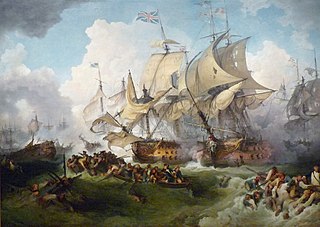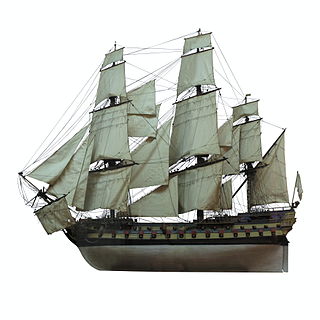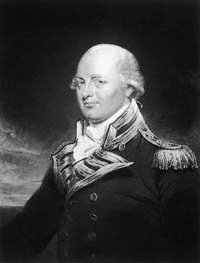
The Glorious First of June, also known as the Fourth Battle of Ushant, was the first and largest fleet action of the naval conflict between the Kingdom of Great Britain and the First French Republic during the French Revolutionary Wars.

Louis-Thomas Villaret de Joyeuse was a French Navy officer and politician. He was born in Auch. After serving in the Indies under Suffren, he rose in rank during the early stages of the French Revolution. He was in command of the French fleet during the Glorious First of June, where despite being handed a heavy tactical defeat, he ensured the passage of a vital grain convoy to France.

HMS Bellerophon, known to sailors as the "Billy Ruffian", was a ship of the line of the Royal Navy. A third-rate of 74 guns, she was launched in 1786. Bellerophon served during the French Revolutionary and Napoleonic Wars, mostly on blockades or convoy escort duties. She fought in three fleet actions: the Glorious First of June (1794), the Battle of the Nile (1798) and the Battle of Trafalgar (1805). While the ship was on blockade duty in 1815, Napoleon boarded Bellerophon so he could surrender to the ship's captain, ending 22 years of almost continuous war between Britain and France.

The Battle of Groix was a large naval engagement which took place near the island of Groix off the Biscay coast of Brittany on 23 June 1795 during the French Revolutionary Wars. The battle was fought between elements of the British Channel Fleet and the French Atlantic Fleet, which were cruising in the region on separate missions. The British fleet, commanded by Admiral Lord Bridport, was covering an invasion convoy carrying a French Royalist army to invade Quiberon, while the French under Vice-admiral Villaret de Joyeuse had sailed a week earlier to rescue a French convoy from attack by a British squadron. The French fleet had driven off the British squadron in a battle on 17 June known as Cornwallis's Retreat, and were attempting to return to their base at Brest when Bridport's force of 14 ships of the line appeared on 22 June.

Océan was a 118-gun first-rate three-decker ship of the line of the French Navy, lead ship of her class. She was funded by a don des vaisseaux donation from the Estates of Bourgogne.

James Bowen was an officer of the Royal Navy.

Vengeur du Peuple was a 74-gun ship of the line of the French Navy. Funded by a don des vaisseaux donation from the Chamber of Commerce of Marseille, she was launched in 1766 as the Marseillois.

Tyrannicide was a 74-gun ship of the line of the French Navy.

HMS Brunswick was a 74-gun third rate ship-of-the-line of the Royal Navy, launched on 30 April 1790 at Deptford. She was first commissioned in the following month under Sir Hyde Parker for the Spanish Armament but was not called into action. When the Russian Armament was resolved without conflict in August 1791, Brunswick took up service as a guardship in Portsmouth Harbour. She joined Richard Howe's Channel Fleet at the outbreak of the French Revolutionary War and was present at the battle on Glorious First of June where she fought a hard action against the French 74-gun Vengeur du Peuple. Brunswick was in a small squadron under William Cornwallis that encountered a large French fleet in June 1795. The British ships successfully retreated into the Atlantic through a combination of good seamanship, good fortune and deceiving the enemy.

The Atlantic campaign of May 1794 was a series of operations conducted by the British Royal Navy's Channel Fleet against the French Navy's Atlantic Fleet, with the aim of preventing the passage of a strategically important French grain convoy travelling from the United States to France. The campaign involved commerce raiding by detached forces and two minor engagements, eventually culminating in the full fleet action of the Glorious First of June 1794, at which both fleets were badly mauled and both Britain and France claimed victory. The French lost seven ships of the line; the British none, but the battle distracted the British fleet long enough for the French convoy to safely reach port.

The Glorious First of June of 1794 was the first and largest naval action between the French and British fleets during the French Revolutionary Wars. The action was fought over 400 miles (640 km) west of Ushant, the most western point on Brittany in France, deep in the Atlantic Ocean. The British fleet under Lord Howe was attempting to defeat a French fleet under Villaret de Joyeuse which was in turn attempting to lure Howe away from a grain convoy destined for France from the United States. The future of the French Revolution depended on this 117-strong convoy, which would save France from famine if it arrived safely. Ultimately, both admirals were successful in their ambitions; Howe defeated Villaret in open battle and sunk or captured seven of his ships. Villaret managed to occupy Howe for long enough and inflict sufficient damage that the convoy escaped unscathed.

Admiral Sir Charles Cotton, 5th Baronet was a senior Royal Navy officer of the French Revolutionary and Napoleonic Wars whose service continued until his death in command of the Channel Fleet from apoplexy in 1812. During his service, Cotton saw action off the Eastern Seaboard of the Thirteen Colonies and later at the Glorious First of June. Cotton's most influential service was in 1809 when he planned and executed the evacuation of thousands of British soldiers from Corunna after the disastrous collapse of the land campaign under Sir John Moore.

The Croisière du Grand Hiver was a French attempt to organise a winter naval campaign in the wake of the Glorious First of June.

Admiral Sir Roger Curtis, 1st Baronet, GCB was a Royal Navy officer who enjoyed an extensive career which was punctuated by a number of highly controversial incidents. Curtis served during the American Revolutionary War and the French Revolutionary Wars and was highly praised in the former conflict for his bravery under fire at the Great Siege of Gibraltar, where he saved several hundred Spanish lives at great risk to his own. His career suffered however in the aftermath of the Glorious First of June, when he was heavily criticised for his conduct by several influential figures, including Cuthbert Collingwood. His popularity fell further due to his involvement in two highly controversial courts-martial, those of Anthony Molloy in 1795 and James Gambier in 1810.

HMS Sans Pareil("Without Equal") was an 80-gun third rate ship of the line of the Royal Navy. She was formerly the French ship Sans Pareil, but was captured in 1794 and spent the rest of her career in service with the British.

Jean François Renaudin was a French Navy officer and Rear-Admiral. He is mostly known for captaining the Vengeur du Peuple at the Fourth Battle of Ushant.

Cornwallis's Retreat was a naval engagement during the French Revolutionary Wars in which a British Royal Navy squadron of five ships of the line and two frigates was attacked by a much larger French Navy fleet of 12 ships of the line and 11 frigates. The action took place in the waters off the west coast of Brittany on 16–17 June 1795.

The frigate action of 29 May 1794—not to be confused with the much larger fleet action of 29 May 1794 that took place in the same waters at the same time—was a minor naval engagement of the French Revolutionary Wars between a Royal Navy frigate and a French Navy frigate. The action formed a minor part of the Atlantic campaign of May 1794, a campaign which culminated in the battle of the Glorious First of June, and was unusual in that the French ship Castor had only been in French hands for a few days at the time of the engagement. Castor had previously been a British ship, seized on 19 May by a French battle squadron in the Bay of Biscay and converted to French service while still at sea. While the main fleets manoeuvered around one another, Castor was detached in pursuit of a Dutch merchant ship and on 29 May encountered the smaller independently cruising British frigate HMS Carysfort.
Jean-Michel Mahé was a French Navy officer.

Lord Howe on the Deck of the Queen Charlotte is a 1794 history painting by the British-American artist Mather Brown. It depicts a scene during the Glorious First of June, a naval battle that took place on 1 June 1794 during the French Revolutionary Wars. Fought in the Atlantic Ocean several hundred miles west of France, it ended in a victory for the Royal Navy fleet commanded by Admiral Richard Howe.






















